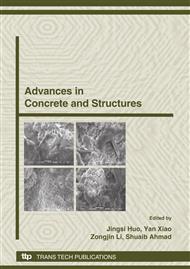p.567
p.575
p.581
p.587
p.593
p.599
p.607
p.613
p.621
Experimental Study on Non-Perpendicular Frame Structure of Tall Building
Abstract:
A shaking table model test is conducted for Guangzhou West Tower to study its seismic behavior in State Key Laboratory for Disaster Reduction in Civil Engineering at Tongji University. Guangzhou West Tower adopts a new structure system and the significant characteristic of this system is the non-perpendicular frame arranged around the building, acting both as columns and bracings. Based on the similarity theory and member equivalent principle,a 1/80 scale model of this building is made of polymethyl methacrylate(PMMA). The model’s dynamic characteristics, earthquake-resistant behavior, responses of acceleration and deformation under different wave peak values are investigated, then the seismic responses of the prototype structure are deduced and analyzed. The whiplash effect of the prototype structure is studied, and the weak position of the structure is found out. The experiment results demonstrate that it is feasible to apply this structural type to practical engineering. Finally, some suggestions for the engineering design of the prototype structure are put forward.
Info:
Periodical:
Pages:
593-598
Citation:
Online since:
October 2008
Authors:
Price:
Сopyright:
© 2009 Trans Tech Publications Ltd. All Rights Reserved
Share:
Citation:


